A Closer Look
Taking a look at the Sentinel DX4000, we have a 4-bay NAS with a mostly metal chassis. The configuration we were given comes with four 3TB Western Digital enterprise drives making for 9TB of effective storage space when configured in RAID 5.
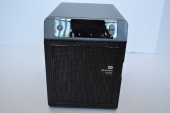 |
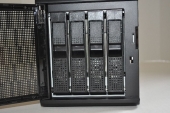 |
One interesting feature is the redundant power supply of Sentinel. You don’t typically see that in consumer grade NAS’s. This just shows that Western Digital is packing some enterprise grade bells and whistles in their small office appliance. Purchasing an additional power brick to enable redundant power will set you back $60. Also included on the back of the NAS are 2 USB 3.0 ports and dual gigabit NIC’s to help in your high speed data transfers.
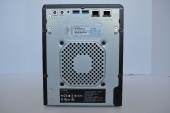 |
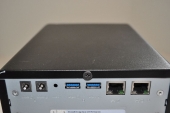 |
The LCD screen on the front of the device shows important information for the system such as the IP address, disk space free and diagnostic information if there is a problem. One thing I would have liked to see displayed was CPU utilization, but it isn’t a deal breaker that it’s not there.
One minor annoyance that I noticed is that even when the unit is powered off, the fan still runs at full power. Western Digital has commented in their forums about this, saying that it is done by design.
Supported RAID Levels
The RAID level that the Sentinel is configured in is entirely dependent on how many drives are in the device. The end user is unable to configure the RAID level. You are stuck with RAID 1 for 2 drives and RAID 5 for anything over 2 drives. This helps simplify things for business owners who may not be the most tech savvy and not know what various RAID levels are or how they perform. On the other hand, this does take away control from power users and experts who enjoy tinkering with RAID volumes.
Drive Limitations
One decision that Western Digital has made for this product that is bound to upset the more tech savvy, is the limitation of what drives can be used in the device. Western Digital has a list of approved drives here. This means that not even all of Western Digital’s drives will work with the device, only specific ones on the list. I can see why they’re taking this approach. It’s very similar to what Apple has done for their line of products, by controlling the part supply you can control the quality of the product. Western Digital is marketing the Sentinel as pretty much a plug in appliance for small businesses. In this particular scenario, it’s not a strike against them for limiting the supply line for replacement drives.
Under The Hood
Disassembling the DX4000 is a fairly straight forward process. There are 5 screws on the back that you have to remove to take off the outer casing.
Once the outer casing is off, you can see the motherboard of the unit. We will get to checking out the motherboard soon, but first we remove it by taking care of the attached ribbon cable for the front display and the 6 screws that hold the board to the case.
With the motherboard removed, we see the top spring mechanism of the drive bays along with the PCIE connector that attaches the drive backplane to the the motherboard.
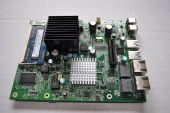 |
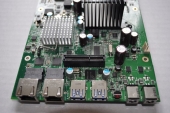 |
The motherboard has a single PCIE slot that it uses to connect to the drives. The CPU as well as the Southbridge are passively cooled on the board.
We can see that the mobo only has a single RAM slot. It is populated with a 2GB stick of hynix DDR3 RAM. Due to a lack of spare parts on hand, we are unsure if you can just drop in a larger capacity RAM stick as an upgrade or if it is somehow locked like the types of hard drives you can use.
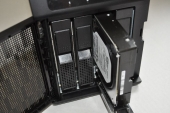
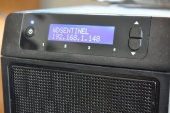
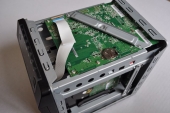
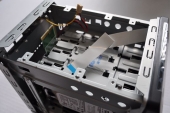
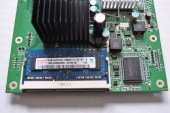

What makes you think this is a pci-e connection instead of just a similar form factor connector using Sata/SAS signalling ?
I am betting its the latter and they are not using a hardware raid chipset anywhere on this device. I want know more about the system to see if it is entirely software based. as it would be easy to force it to do a raid 0 setup if that were to be the case
When I read your comment I went ahead and disassembled the NAS again to make sure I hadn’t missed something. There is no discrete RAID chip connected on the backplane. It is instead using an Intel ICH9R chipset on the motherboard for hardware RAID. As far as the PCIe not actually being what it looks like, it appears that we may both be correct. Some motherboards are able to use their PCIe slots as SATA ports, but still retain PCIe functionality when a drive isn’t plugged in. I think that may be what they’re doing in this instance.
All that being said, I can’t really see the point in enabling a RAID 0 on a device like this. It’s main purpose is to keep data safe, something completely defeated when using RAID 0. I could see you wanting to use something like RAID 1+0 though.
Well with dual GBe and sudo software raid that the ich 9r provides you will probably limit throughput by the ich9r chipset or cpu.
In some situation with multiple people accessing large files at the same time performance can really degrade, so a raid 0+1 would provide better throughput because of less overhead in the parity calculations.
With some enhancements a raid 0+1 can read just as fast or faster than a 4 disk raid5 (again parity calculations, more read heads available with less processing overhead delays), just like in some cases a 2 disk raid 1 array can read faster than an identical single drive on the same controller (read optimization’s, more heads available).
I wonder how this device will perform in a realistic home use situation ( 2 parents 2 children, accessing multimedia content, dvd backups, home movies, and pictures ) or an office situation ( 5-10 people with office documents, access/quicken database, and pictures ) with 2 drives in raid 1 vs 4 drives in raid 5
For the performance you just included screen shots of the Windows transfer manager! LOL